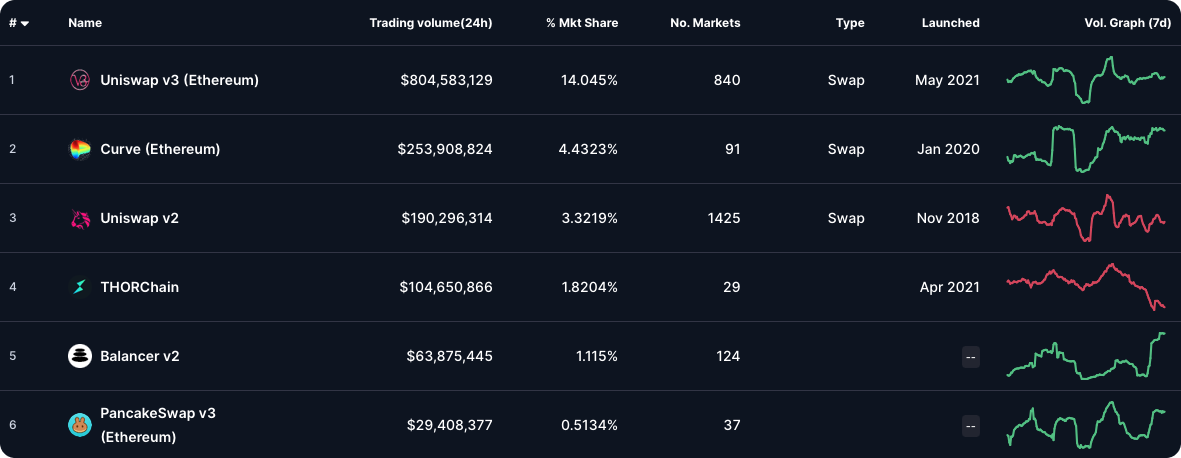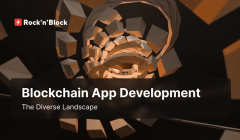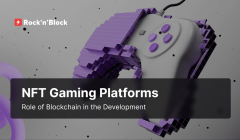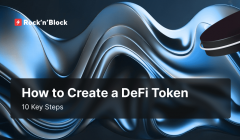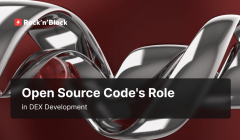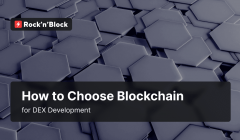Top 5 Decentralized Exchanges on Ethereum
03 May 2024In this article, we delve into the landscape of decentralized exchanges on Ethereum, uncovering the top 5 platforms that have not only revolutionized the way we trade but have become trailblazers in the rapidly evolving world of DeFi development. Take a comprehensive journey through this leading decentralized exchanges on Ethereum. Explore their strengths and nuances that define their roles in shaping the decentralized financial landscape and DEX development.

Table of Contents:
-
The Rise of DEXs in the DeFi Landscape
-
The Ethereum Impact on the Decentralized Exchange Development
-
5 Best DEXs on Ethereum
-
Uniswap
-
Curve Finance
-
THORChain
-
Balancer
-
PancakeSwap
-
Conclusion
The Rise of DEXs in the DeFi Landscape
The rise of decentralized exchanges has been a pivotal force in the dynamic landscape of decentralized finance. As the need for trustless and permissionless trading solutions grew, decentralized exchange development became a key driver of innovation. DEXs, which are powered by smart contracts, enable peer-to-peer transactions, eliminating the need for intermediaries and giving users complete control over their assets. DEX development has evolved to include diverse trading models, such as automated market makers (AMMs) and unique liquidity pool structures, which have become integral to the DeFi experience. The decentralized nature of DEXs attracted users seeking financial autonomy and security. The rise of DEX development has revolutionized the way users engage with digital assets and has also created a flourishing ecosystem that is constantly pushing the limits of what is achievable in decentralized finance on Ethereum.
The Ethereum Impact on the Decentralized Exchange Development
Ethereum is crucial to the decentralized exchanges development. As a leading blockchain platform, Ethereum's flexible and easily programmable smart contracts provide the foundation for the creation and execution of decentralized exchange protocols. The Ethereum blockchain enables trustless and automated transactions, allowing DEXs to function without intermediaries.
Smart contracts development is essential for DEX development on Ethereum. They serve as the backbone for features such as order execution, trade settlement, and liquidity pool creation. These contracts automate the trading process, ensuring transparent and tamper-resistant transactions.
Ethereum's support for ERC-20 tokens is another advantage for DEX development. The Ethereum blockchain uses standardized tokens to enable the smooth exchange of a variety of digital assets within the DEX ecosystem.
Furthermore, Ethereum's role goes beyond basic DEX functionality. The platform has been a hub for defi protocol development, fostering the creation of innovative financial instruments, yield farming protocols and governance structures within the DEX ecosystem. Ethereum's active and engaged developer community consistently pushes the limits of DEX development, introducing upgrades and optimizations that improve the overall user experience.
In summary, Ethereum's programmable blockchain and support for token standards have been pivotal in shaping the DEX development landscape. As the decentralized finance ecosystem evolves, Ethereum remains a crucial enabler, providing the infrastructure necessary for the creation and advancement of decentralized exchanges that empower users in the new era of digital finance.
5 Best DEXs on Ethereum
DeFi development has revolutionized the financial ecosystem by using transparent and open protocols. Decentralized exchanges are central to the DeFi movement, and Ethereum serves as the foundation for these innovative platforms. In this section, we will explore the top 5 DEXs on Ethereum, examining their distinctive features, user experiences, and contributions to the broader realm of DEX development.
Please note that this information is current at the time of publication. Source: CoinMarketCap
Uniswap
Uniswap stands as a paramount platform for decentralized exchange development, setting industry standards with its innovative automated market maker model and playing a pivotal role in shaping the landscape of decentralized finance on the Ethereum blockchain. Uniswap V2 and V3 are successive versions of this protocol. Both versions contribute to Uniswap's prominence in the DeFi space.
Core features
1. Automated Market Maker (AMM) Model: Uniswap operates on an AMM model, eliminating the need for traditional order books. Instead, it utilizes liquidity pools and smart contracts to facilitate direct token swaps between users.
2. Liquidity Pools: Uniswap's liquidity pools allow users to contribute their tokens to facilitate trading. Liquidity providers earn fees in proportion to their contribution, fostering community participation and liquidity within the platform.
3. UNI Governance Token: Uniswap introduced the UNI governance token, granting users voting rights in the platform's governance decisions. This inclusion of the community in decision-making enhances the decentralized nature of Uniswap and gives users a sense of ownership in the protocol's evolution.
Advantages
1. Continuous Innovation with Uniswap v3: The release of Uniswap v3 marked a significant milestone in DEX development. The introduction of concentrated liquidity dex development allows users to strategically allocate funds within a specific price range, enhancing capital efficiency. Uniswap's commitment to continuous improvement underscores its role as a pioneer in shaping the trajectory of DEX development on Ethereum.
2. Wide Range of Supported Tokens: Uniswap supports a wide array of ERC-20 tokens, providing users with diverse options for trading. This inclusivity contributes to the platform's appeal and allows for a variety of trading preferences.
3. Low Barrier to Entry: Uniswap's decentralized nature and user-friendly design lower the barrier to entry for users interested in participating in decentralized finance. Users can trade without the need for a traditional financial intermediary, promoting financial inclusivity.
Challenges
1. Impermanent Loss for Liquidity Providers: One notable challenge in Uniswap and DEX development, in general, is the concept of impermanent loss. Liquidity providers may experience changes in the value of their staked assets due to changes in market prices, potentially resulting in losses compared to simply holding the assets.
2. Network Congestion and Gas Fees: Uniswap often faces challenges related to network congestion and gas fees during periods of increased market activity. High gas fees can scare smaller traders and liquidity providers, limiting accessibility and raising concerns about the scalability of DEX.
3. Competition and Market Fragmentation: The rapid growth of the DeFi ecosystem has led to increased competition among DEXs. While this competition can drive innovation, it also results in market fragmentation, with users spread across various platforms. This fragmentation poses challenges for liquidity aggregation and may impact the overall efficiency of DEX.
Check our comprehensive guide on how to Create a DEX like Uniswap!
Uniswap's influence on DEX development cannot be overstated, and its advantages in user experience and continuous innovation have pushed it to the forefront of the decentralized finance movement. As Uniswap faces main challenges, its journey reflects the overall progress happening in the decentralized finance world.
Curve Finance
Curve Finance has carved a niche in DEX development by specializing in stablecoin trading. The platform is designed to offer low-slippage swaps for assets with similar values, minimizing impermanent loss for liquidity providers.
Core Features
1. Stablecoin Swaps: Curve Finance specializes in stablecoin trading, focusing on minimizing slippage for assets pegged to the same value. This focus on stable assets sets Curve apart and makes it the platform of choice for traders seeking the highest precision in stablecoin trading.
2. Curve DAO Governance Token: The Curve DAO allows users to participate in the governance of the protocol. It grants holders voting rights, enabling them to propose and vote on changes to the Curve Finance ecosystem.
3. Low Transaction Costs: Curve's focus on stablecoin swaps contributes to lower transaction costs, making it an attractive option for users looking to trade stable assets efficiently and cost-effectively.
Advantages
1. Low Slippage for Stablecoin Trades: Curve Finance's algorithm minimizes slippage for stablecoin trades, providing users with a more predictable and cost-effective trading experience compared to traditional DEXs.
2. Diverse Stablecoin Pools: Curve Finance supports various stablecoins, including popular ones like USDC, DAI, USDT, and more. The availability of diverse stablecoin pools allows users to access a wide range of trading pairs and choose the stable assets that best suit their needs.
3. Community Governance with CRV Token: The inclusion of the CRV token in the governance structure empowers the community to shape the future of Curve Finance. This decentralized governance model aligns with the principles of the broader DeFi movement.
Challenges
1. Limited Asset Variety: Curve Finance's specialization in stablecoins means that the platform may not offer the same variety of assets as other DEXs. Users seeking a broader range of tokens may need to use additional platforms.
2. Complexity of Stablecoin Dynamics: The nuances of stablecoin dynamics, including maintaining pegs and balancing different stable assets, can add complexity. DEX developers and users need to understand how these dynamics work, especially when creating or using liquidity pools, in order to minimize risk and optimize their strategies.
3. Potential Risks in Yield Farming: While yield farming presents opportunities for additional income, it also comes with risks. Users engaging in yield farming strategies should be mindful of potential impermanent loss and market volatility.
Curve Finance has carved a niche for itself in the decentralized finance ecosystem, offering an efficient platform for stablecoin swaps. As users explore the features and opportunities within Curve, it's essential to consider both the advantages and potential challenges, aligning their choices with their specific trading goals and risk tolerance in the world of DeFi.
THORChain
Launched in 2018, THORChain's primary goal is to facilitate seamless and trustless token swaps and DEX development.
Core Features
1. THORSwap: THORSwap, designed for the Ethereum network, facilitates swaps among various ERC-20 tokens.
2. Native Token: The native token of THORChain is RUNE. Beyond its role in governance, RUNE holders contribute to network security, receive staking rewards, and play a part in shaping the protocol's future.
3. Cross-Chain Swaps: THORChain's standout feature is its ability to facilitate trustless and decentralized swaps of assets across different blockchain networks. This cross-chain compatibility enhances interoperability in the DeFi space.
Advantages
1. Interoperability Focus: THORChain's emphasis on interoperability breaks down barriers between blockchain networks, fostering a more interconnected decentralized finance ecosystem and expanding the reach of assets.
2. Native Token (RUNE) Utility and Governance: The native token, RUNE, serves multiple purposes, acting as a utility token for transactions and governance. This dual functionality empowers users, allowing them to actively participate in decision-making while enjoying the benefits of a native token within the THORChain ecosystem.
Challenges
1. Cross-Chain Complexity: Facilitating true cross-chain functionality introduces complexity. The technical challenges of seamlessly connecting various blockchains can lead to potential operational hurdles and delays in decentralized exchange development.
2. Extensive Codebase: The THORChain platform is highly complex, which makes it challenging to onboard new developers. Experienced developers must dedicate significant time to guide and educate newcomers, or risk facing substantial difficulties if they decide to leave.
THORChain stands as a promising project in the decentralized exchange development ecosystem, working towards breaking down the barriers between blockchain networks and fostering a more interconnected and accessible crypto ecosystem.
Balancer
Balancer is a decentralized exchange and automated portfolio manager that allows users to create and manage liquidity pools with multiple assets.
Core Features
1. Automated Portfolio Management: Balancer offers automated portfolio management, allowing users to create and manage liquidity pools with multiple assets and different weights. This enables dynamic balancing of the portfolio based on market conditions.
2. Smart Order Routing: The protocol includes smart order routing, optimizing trade execution across multiple liquidity pools to achieve the best possible rates for users.
3. Single-Token Exposure: Balancer allows users to hold a single liquidity pool token representing their share in the pool, simplifying the management of their portfolio without the need to hold individual tokens.
Advantages
1. Flash Loans with V2: Balancer supports flash loans, enabling users to borrow assets without collateral as long as the borrowed assets are returned within the same transaction.
2. Integration with DeFi Ecosystem: Balancer is designed to integrate seamlessly with other DeFi protocols, allowing users to leverage its liquidity pools for various decentralized applications.
3. Enhancing Efficiency: Improved liquidity mechanisms in Balancer V2 offer significant benefits in terms of capital and gas efficiency when compared to Balancer V1.
Disadvantages and Challenges
1. Complexity for New Users: The platform's features, especially the creation and management of liquidity pools, may be complex for new users. Navigating the system might require a learning curve, potentially scaring less experienced users.
2. Flash Loan Exploits: The support for flash loans, while innovative, can expose the platform to potential exploits. Flash loan-enabled attacks have affected DeFi protocols, and Balancer is not immune to such risks.
Balancer emerges as a significant player in decentralized exchange development, offering advanced features for liquidity management. With its emphasis on automation and decentralized governance, Balancer V2 enhances efficiency. Despite its strengths, users should be mindful of challenges. As DeFi evolves, Balancer's ongoing development positions it as a significant contributor to DEXs ecosystem, urging users to stay informed about updates and security measures in this dynamic landscape.
PancakeSwap
Launched in 2020, PancakeSwap is a decentralized exchange known for its low transaction fees and fast confirmation times.
Core Features
1. CAKE Token: CAKE serves as the native utility and governance token of PancakeSwap. Holders can participate in governance decisions and earn rewards through staking platform development.
2. Syrup Pools: PancakeSwap introduces Syrup Pools, allowing users to stake CAKE tokens to earn other tokens as rewards.
Advantages
1. Efficiency: PancakeSwap V3 introduces an enhanced and adaptable platform catering to both traders and liquidity providers.
2. Wide Range of Token Pairs: PancakeSwap supports a diverse range of token pairs, providing users with a variety of options for trading and liquidity provision.
3. Lower Impermanent Loss: PancakeSwap's concentrated liquidity dex development model in V3 aims to reduce impermanent loss for liquidity providers, improving the overall efficiency of providing liquidity.
Disadvantages and Challenges
1. Limited Integration with External Platforms: PancakeSwap's integration with external platforms and services might be more limited compared to DEXs on more established blockchains. Such limitations may have an effect on users seeking effortless experiences across multiple DeFi applications.
2. Regulatory Risks: As with any DeFi platform, PancakeSwap faces regulatory uncertainties, and changes in regulatory landscapes could impact its operations.
PancakeSwap's innovative approaches, such as the introduction of syrup pools and concentrated liquidity in V3, showcase its commitment to evolving and addressing the evolving needs of the DEX ecosystem.
Check our comprehensive guide on how to Create a DEX like PancakeSwap!
Conclusion
As we explore the decentralized landscape on Ethereum, the following 5 DEXs not only offer diverse solutions for users but also contribute significantly to the ongoing history of DEX development. These platforms showcase pioneering models and specialized approaches, underscoring the dynamic nature of decentralized finance.
As the DeFi landscape progresses, these platforms will certainly continue to evolve, introducing new features, optimizing the user experience, and contributing to the broader narrative of financial inclusivity powered by blockchain technology. The decentralized journey has only just begun, and these exchanges act as stars guiding us towards a more accessible and decentralized financial future.
We ❤️ Development
Follow us on social media to receive the hottest blockchain development updates
Crunchbase ⚡️Twitter ⚡️Telegram⚡️LinkedIn⚡️Facebook⚡️Instagram⚡️Quora
